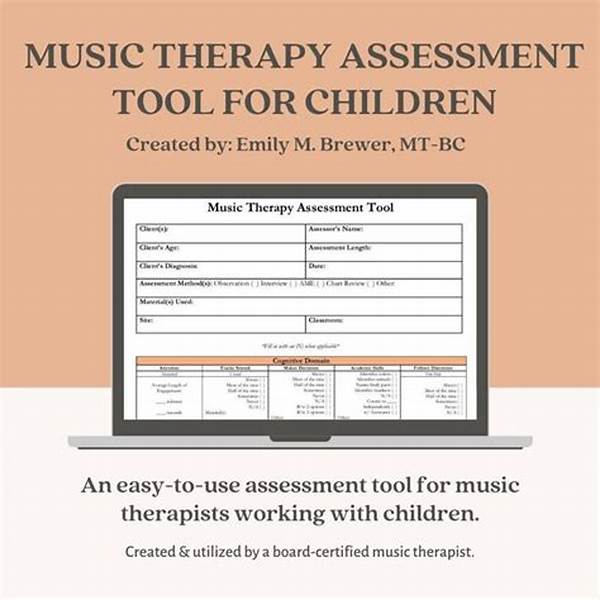If you’re vibing to the groove of music therapy, you probably know it’s not all headphones and good vibes. It’s mad scientific, too! Music therapy outcome measurement standards? Sounds like serious business, right? These bad boys set the scene for how therapists measure the success of their jazz. We’re diving into how these standards shake up the therapy game, making sure every beat counts.
Read Now : Dynamic And Expressive Soundscapes
Why Music Therapy Outcome Measurement Standards Matter
So, imagine you’re jammin’ out with your therapist, and you’re like, “Yo, are we making progress or just vibin’?” That’s where music therapy outcome measurement standards crash the party. They’re the unsung heroes, ensuring that therapy sessions don’t just hit the right notes but actually make a difference. These standards are like the ultimate mixtape, blending clinical precision with the healing power of music to crank up those positive outcomes. By establishing solid benchmarks, therapists can track progress, making sure their patients get the real MVP treatment. It’s about keeping the groove legit and the results lit!
See, the world of therapy isn’t just about freestyle. Nah, it’s like operating in a DJ booth, where every move has to be on point. These standards are like the beat drop of therapy—without them, you’d be lost in noise. They provide a clear pathway to gauge how effective the sessions are. Therapists use these standards to navigate through the therapeutic process, ensuring every session counts, every tune has a purpose, and every melody contributes to the healing journey. So, next time you’re vibin’ in a session, know that music therapy outcome measurement standards got your back, making sure every beat matters.
What You Need to Know About Music Therapy Outcome Measurement Standards
1. These standards are like the cheat codes for quality. They ensure everything’s on track and nothing’s out of tune.
2. Without them, tracking progress is like trying to groove without a rhythm. It’s chaos!
3. They set the tone for consistency; like hitting replay on your fav album.
4. Think of them as the GPS in therapy, keeping everyone on the healing track.
5. They’re crucial for setting goals, so patients aren’t left in the dust, wandering aimlessly.
Music Therapy Outcome Measurement Standards: The Deep Dive
Let’s break it down further, no cap. Music therapy outcome measurement standards are the backstage pass to the inner workings of a killer therapy session. They’re not just about tickin’ boxes or fillin’ charts. Nah, they’re all about elevating the experience, making every strum of a guitar or beat of a drum purposeful. Imagine walking into a dark room filled with all the potential in the world. These standards flip the switch, illuminating the way forward, guiding the process, and ensuring no beats are skipped in the journey.
The standards help therapists craft tailor-made sessions that resonate with each individual’s needs. It’s like making a custom playlist, perfectly attuned to a person’s vibe and rhythm. These guidelines equip therapists with tools to evaluate progress in a structured yet creative manner. The standards ensure that amidst the flow and harmony, the real therapeutic beats are never drowned out. With these standards, therapy isn’t just random jamming; it’s a symphony of healing.
Dive Into the Groove: How Music Therapy Outcome Measurement Standards Set the Bar
So, you’re wondering, what’s the magic behind these standards? Here’s the lowdown.
1. They rock a solid framework for consistent evaluation.
2. Each standard plays a unique role, like instruments in a band.
3. They guide therapists to measure both tangible and intangible improvements.
Read Now : Songs That Boost Confidence And Empowerment
4. These standards foster a transparent therapy environment.
5. The standards help in crafting sessions that resonate with individual needs.
Understanding Music Therapy Outcome Measurement Standards: The Low-Key Magic
Just imagine kicking back with a dope playlist shaping your every move—that’s music therapy with outcome measurement standards. Therapist sessions are more transformative, like hitting the bass on a heart-pounding track. These standards are the secret sauce, ensuring the synergy between art and science doesn’t go amiss. It’s about mixing emotive melodies with rock-solid data to serve clients the best experiential therapy imaginable.
At the heart of it, these measurement standards forge a deeper connection between therapist and client, opening channels for authentic communication. They help challenge normal therapy boundaries, prompting therapists to get creative while remaining true to clinical objectives. Each session is thus not just an emotional escape but a targeted approach to real, quantifiable results. With music therapy outcome measurement standards, therapy becomes a medley of evidence-based practices dancing in harmony with the expressive power of music, creating possibilities of growth, healing, and change in their most superlative form.
Jam Session: What Music Therapy Outcome Measurement Standards Bring to the Table
1. Establish definitive benchmarks to monitor client progression.
2. Blend creativity with clinical goals.
3. Ensure personalized, client-centered sessions.
4. Elevate therapy sessions from basic compositions to masterful symphonies.
5. Provide feedback loops for clients, helping them see tangible growth.
Wrapped Up: Summary of Music Therapy Outcome Measurement Standards
For all you rookies out there diving into the world of therapy, remember—it’s not all feels and no games. Music therapy outcome measurement standards weave an intricate labyrinth of data-driven benchmarks and expressive freedom, ensuring the essence of music isn’t lost amidst scientific rigor. These standards illuminate the therapeutic path, ensuring every tune played has the strength to heal and transform.
With outcomes as the focus, music therapists can orchestrate sessions that don’t just soothe the soul but yield tangible results, hyping the healing process. They foster understanding and clarity, bridging the gaps that often exist in traditional therapy approaches. So, next time you’re in a session, think about these standards being at the heart of that rhythm and rhyme—paving the way for a more structured, impactful, and harmonious therapy experience. It’s therapy that jams hard and heals even harder, all thanks to these rock-solid music therapy outcome measurement standards.
